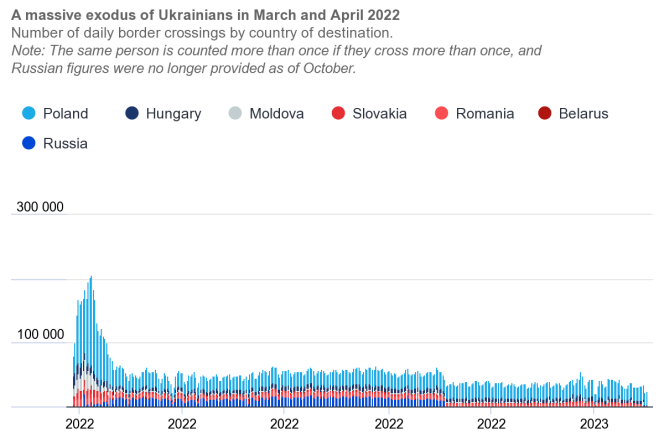
On February 24, 2022, the Ukrainians woke up from a long night punctuated by bombings: Russian troops had invaded the country.
The exodus began: Some accompanied their families out of the country before returning to the fighting, others rushed to the borders in cars or on crowded trains. First, they had to pass through a neighboring country.
In the early days of the war, hundreds of thousands of Ukrainians turned west to Poland, Hungary, Slovakia, Romania or Moldova. On March 6, alone, the United Nations High Commissioner for Refugees (UNHCR) recorded a peak of 140,843 crossings at the Ukrainian-Polish border. At the end of March, more than 2 million had passed through Poland.
The migration crisis was reaching an unprecedented scale. According to the UNHCR, as of February 15, 2023, almost a year after the war began, 8,072,198 Ukrainian refugees have been registered in Europe, representing 18% of their country's population.
The majority of departures occurred in March 2022, with over 3 million border crossings. Since then, there have been between 1 and 1.5 million passages each month. But it is not always to flee the country: Ukrainians may return to their city to visit relatives, before leaving for a border country.

According to a UNHCR survey of 17,750 Ukrainian exiles, 15% were willing to return to their country once to see relatives. According to the same study, the vast majority of civilians who have fled the war are women over 35 with one or more children. The general mobilization, decreed on February 24, 2022, in Ukraine, forbidding men from 18 to 60 years old to leave the country, means they are very few.
Ukrainians fleeing to Russia
To the north, east and southeast, Ukraine is bordered by Belarus and Russia. In the first weeks of the conflict, Russian troops advanced rapidly and thousands of Ukrainians found themselves trapped behind the front lines and tried to flee wherever they could, including to Russia, which was often the most accessible option. At the end of March, UNHCR counted more than 280,000 crossings at the Russian border.
But, quickly, the Ukrainian government accused Russia of deporting its citizens, "including in the so-called self-proclaimed republics of Donetsk and Luhansk, since populations that may have been present there since 2014 were also forcibly displaced," said Thomas Chopard, a historian who specializes in Ukraine.
Temporary protection status in the EU
Swiftly, Europe made arrangements to welcome the populations fleeing the war. On March 3, 2022, the ministers of the European Union (EU) used for the first time a 2001 directive "on minimum standards for giving temporary protection in the event of a mass influx of displaced persons."
Ukrainian nationals were entitled to temporary protection status in all EU countries, with broad access conditions: A year after the war, 4.8 million applications were registered.
Poland and Germany are the countries that have granted the most refugee status, followed by the Czech Republic. But in proportion to the size of their country, the Czechs have taken the largest share: Ukrainian refugees represent more than 4% of the total population.
Estonia ranks second (2.9%), followed by Poland. France comes a long way behind: According to data from the European Eurostat database, for the month of December 2022, it counted just over 65,000 refugees (or 0.1% of the population), a figure to be taken with caution, as the previous month's count was about 128,000 (or about 0.2%).
A temporary reception in some Eastern countries
The Ukrainians spread out to different European countries, first to the east of the country, then to Central and Western Europe. This shift towards the west can be explained initially by "the precariousness of reception conditions in border countries, which have taken in refugee populations very temporarily, have registered them, but never with a view to receiving them in the medium term. This is the case of Moldova, a small country with very limited reception conditions", Chopard said.
Subsequently, "there were sometimes policies that were relatively hostile to a longer stay of Ukrainian refugee populations. Notably in Hungary, which admittedly welcomed Ukrainian populations on a massive scale and registered them, but on the very explicit condition that they continue their migration to the west immediately," he added.
As time went on and Ukrainian counter-offensives took place, some civilians returned to their hometowns. In Kyiv, residents gradually returned in late spring as Russian forces moved away.
The important role of diasporas
Poland is an exception among the border countries since a significant proportion of Ukrainians in exile have settled there for the medium or long term. The country has issued more than 1.5 million temporary protection statuses.
The Ukrainian diaspora, estimated at over 1 million people before the war, played an important role in the settlement of the new refugees. In the countries furthest west, the diaspora has also been important.
As early as May 2022, more than 100,000 Ukrainians had received temporary protection in Spain. The same number was attained in Italy by July. In both countries, Ukrainians already on the ground pressured local authorities to set up reception facilities.
Governments have also responded in an unprecedented way to welcome Ukrainian exiles. Germany is the country that has issued the second most temporary protection statuses behind Poland and ahead of the Czech Republic, according to the latest Eurostat data.
As Chopard explained, previous experiences in France have led to few Ukrainians coming to take refuge there: "This low reception today is probably one of the longer-term consequences of the policies of rejection, of lack of welcome, which played out in particular at the time of the vast Syrian exodus in 2015."